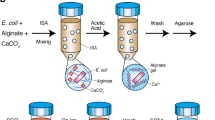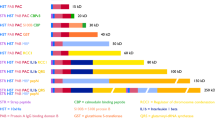Abstract
Contour-clamped homogeneous electric field (CHEF) electrophoresis is a technique of pulsed-field gel electrophoresis that enables the resolution of large fragments of DNA that cannot be resolved by conventional gel electrophoresis. The procedure involves the application of controlled electric fields that change direction at a predetermined angle to samples of DNA that have been embedded in an agarose gel matrix and digested with a restriction endonuclease. Adjustment of the electrophoresis conditions enables the separation of DNA fragments with lengths from 10 kilobases up to 9 megabases in a size-dependent manner in agarose gels. The banding patterns can be used for epidemiological typing, the separated DNA can be immobilized onto a membrane and used for genetic mapping, or individual fragments can be extracted and used for downstream genetic manipulations. The protocol requires specialized equipment and can be completed in a maximum of 7 days.
This is a preview of subscription content, access via your institution
Access options
Subscribe to this journal
Receive 12 print issues and online access
$259.00 per year
only $21.58 per issue
Buy this article
- Purchase on Springer Link
- Instant access to full article PDF
Prices may be subject to local taxes which are calculated during checkout

Similar content being viewed by others
References
Schwartz, D.C. & Cantor, C.R. Separation of yeast chromosome-sized DNAs by pulsed field gradient gel electrophoresis. Cell 37, 67–75 (1984).
Chu, G., Vollrath, D. & Davis, R.W. Separation of large DNA molecules by contour-clamped homogeneous electric fields. Science 234, 1582–1586 (1986).
Southern, E.M. & Elder, J.K. in Pulsed Field Gel Electrophoresis (ed. Monaco, A. P.) 1–19 (Oxford University Press, New York, 1995).
Udo, E.E. & Grubb, W.B. Genetic analysis of methicillin-resistant Staphylococcus aureus from a Nigerian hospital. J. Med. Microbiol. 38, 203–208 (1993).
O'Brien, F.G., Pearman, J.W., Gracey, M., Riley, T.V. & Grubb, W.B. Community strain of methicillin-resistant Staphylococcus aureus involved in a hospital outbreak. J. Clin. Microbiol. 37, 2858–2862 (1999).
O'Brien, F.G. et al. Diversity among community isolates of methicillin-resistant Staphylococcus aureus isolates in Australia. J. Clin. Microbiol. 42, 3185–3190 (2004).
O'Brien, F.G. et al. Survey of methicillin-resistant Staphylococcus aureus strains from two hospitals in El Paso, Texas. J. Clin. Microbiol. 43, 2969–2972 (2005).
Coombs, G.W. et al. Methicillin-resistant Staphylococcus aureus clones, Western Australia. Emerging Infect. Dis. 12, 241–247 (2006).
O'Brien, F.G. et al. Heterogeneous expression of fusidic acid resistance in Staphylococcus aureus with plasmid or chromosomally encoded resistance genes. Pathology 30, 299–303 (1998).
O'Brien, F.G., Price, C., Grubb, W.B. & Gustafson, J.E. Genetic characterization of the fusidic acid and cadmium resistance determinants of Staphylococcus aureus plasmid pUB101. J. Antimicrob. Chemother. 50, 313–321 (2002).
Cox, E.C., Vocke, C.D., Walter, S., Gregg, K.Y. & Bain, E.S. Electrophoretic karyotype for Dictyostelium discoideum. Proc. Natl. Acad. Sci. USA 87, 8247–8251 (1990).
Goering, R.V. Molecular epidemiology of nosocomial infection: analysis of chromosomal restriction fragment patterns by pulsed-field gel electrophoresis. Infect. Cont. Hosp. Epidemiol. 14, 595–600 (1993).
Kuroda, M. et al. Whole genome sequencing of methicillin-resistant Staphylococcus aureus. Lancet 357, 1225–1240 (2001).
Tenover, F.C. et al. Interpreting chromosomal DNA restriction patterns produced by pulsed-field gel electrophoresis; criteria for bacterial strain typing. J. Clin. Microbiol. 33, 2233–2239 (1995).
Pattee, P.A., Lee, H.C. & Bannantine, J.P. in Molecular Biology of the Staphylococci (ed. Novick, R.P.) 41–58 (VCH Publishers, New York, 1990).
Schindler, C.A. & Schuhardt, V.T. Lysostaphin: a new bacteriolytic agent for the staphylococcus. Proc. Natl. Acad. Sci. USA 51, 414–421 (1964).
van Belkum, A. et al. Assessment of resolution and intercenter reproducibility of results of genotyping Staphylococcus aureus by pulsed-field gel electrophoresis of SmaI macrorestriction fragments: a multicenter study. J. Clin. Microbiol. 36, 1653–1659 (1998).
Murchan, S. et al. Harmonization of pulsed-field gel electrophoresis protocols for epidemiological typing of strains of methicillin-resistant Staphylococcus aureus: a single approach developed by consensus in 10 European laboratories and its application for tracing the spread of related strains. J. Clin. Microbiol. 41, 1574–1585 (2003).
Southern, E. Southern blotting. Nature Protocols 1, 518–525 (2006).
Strong, S.J., Ohta, Y., Litman, G.W. & Amemiya, T. Marked improvement of PAC and BAC cloning is achieved using electroelution of pulsed-field gel-separated partial digests of genomic DNA. Nucleic Acids Res. 25, 3959–3961 (1997).
Goering, R.V. & Winters, M.A. Rapid method for epidemiological evaluation of Gram-positive cocci by field inversion electrophoresis. J. Clin. Microbiol. 30, 577–580 (1992).
Acknowledgements
This work was supported by the National Heath and Medical Research Council of Australia and the Western Australian Department of Health.
Author information
Authors and Affiliations
Corresponding authors
Ethics declarations
Competing interests
The authors declare no competing financial interests.
Rights and permissions
About this article
Cite this article
O'Brien, F., Udo, E. & Grubb, W. Contour-clamped homogeneous electric field electrophoresis of Staphylococcus aureus. Nat Protoc 1, 3028–3033 (2006). https://doi.org/10.1038/nprot.2006.382
Published:
Issue Date:
DOI: https://doi.org/10.1038/nprot.2006.382
This article is cited by
-
Resveratrol antibacterial activity against Escherichia coli is mediated by Z-ring formation inhibition via suppression of FtsZ expression
Scientific Reports (2015)
-
Prevalence of nasal methicillin-resistant Staphylococcus aureus colonization in healthcare workers in a Western Australian acute care hospital
European Journal of Clinical Microbiology & Infectious Diseases (2012)
-
Clinical and laboratory features of invasive community-onset methicillin-resistant Staphylococcus aureus infection: a prospective case–control study
European Journal of Clinical Microbiology & Infectious Diseases (2010)
-
Intra-strain variability of methicillin-resistant Staphylococcus aureus strains ST228-MRSA-I and ST5-MRSA-II
European Journal of Clinical Microbiology & Infectious Diseases (2009)
Comments
By submitting a comment you agree to abide by our Terms and Community Guidelines. If you find something abusive or that does not comply with our terms or guidelines please flag it as inappropriate.



